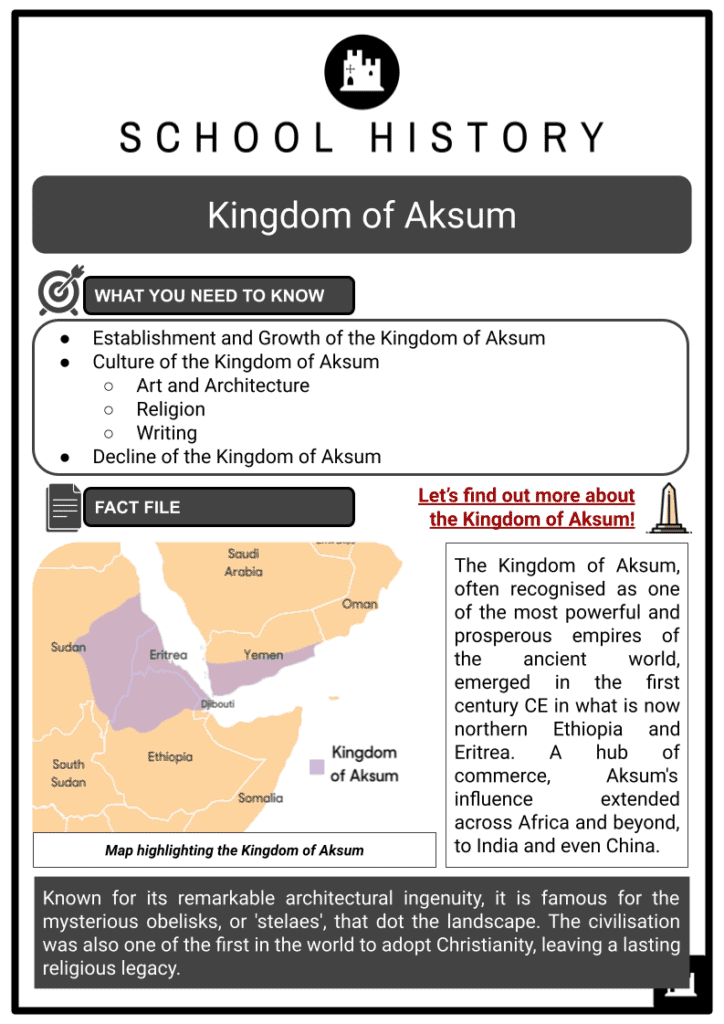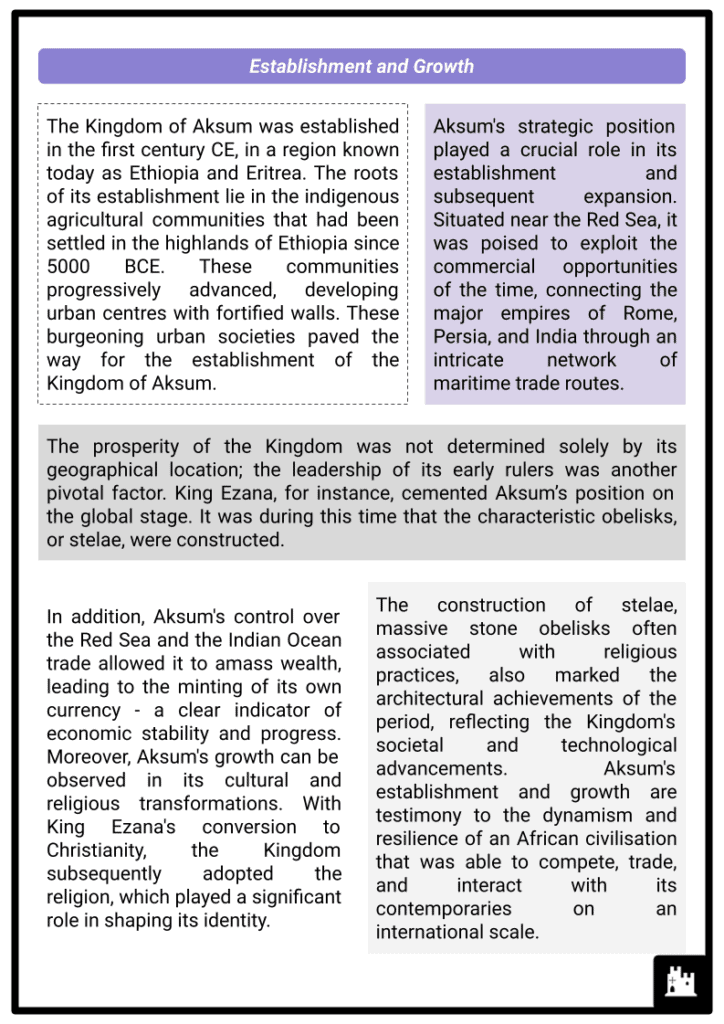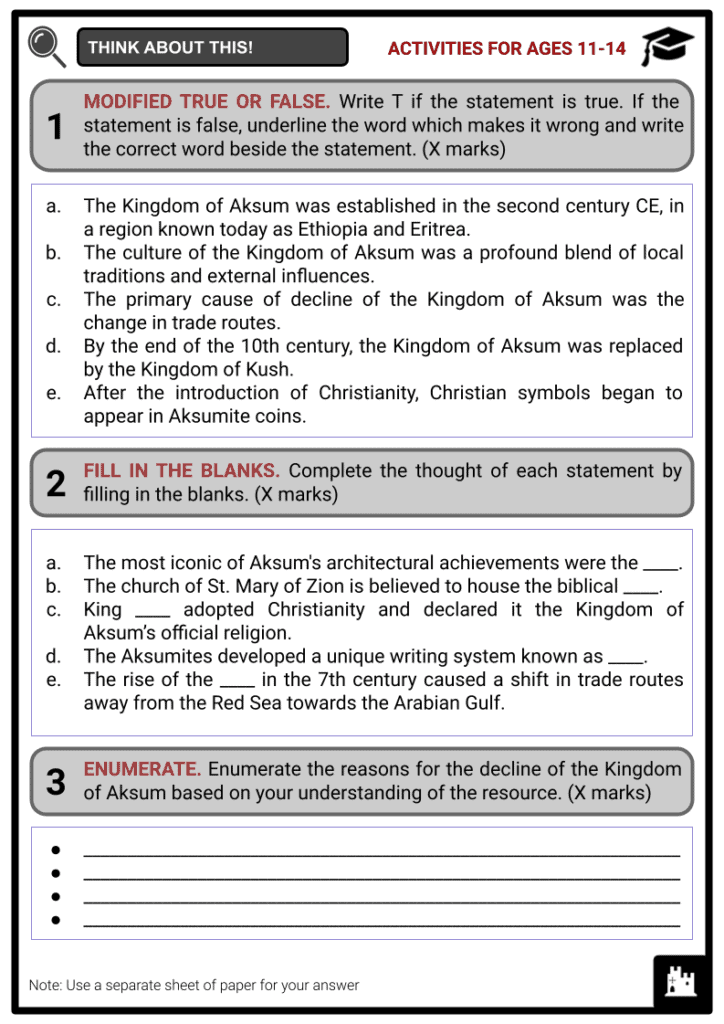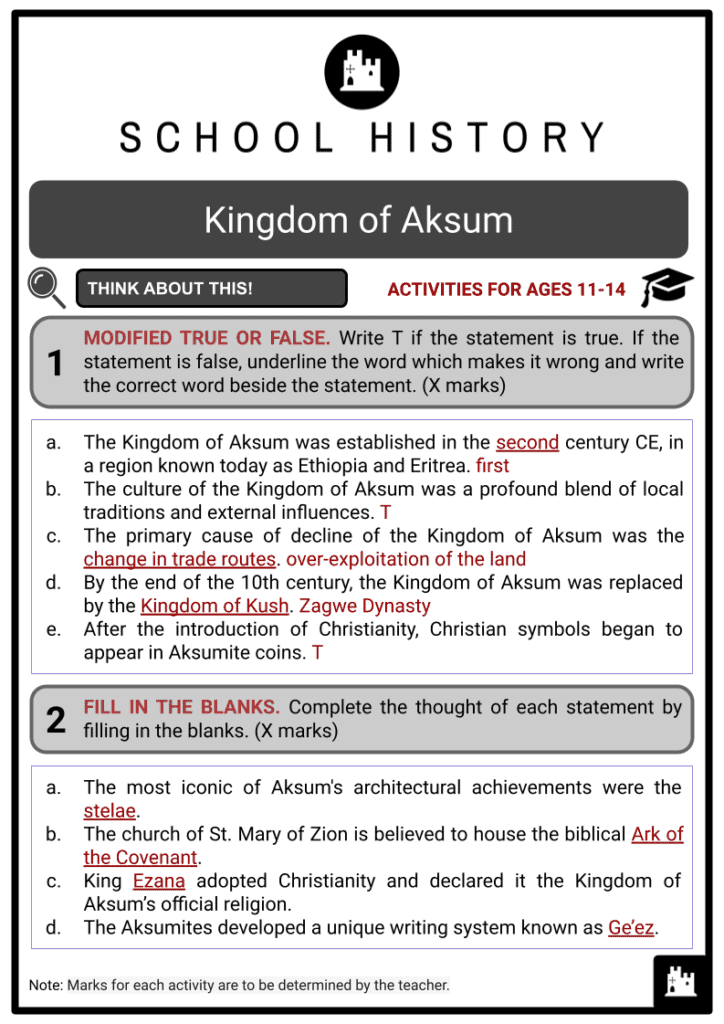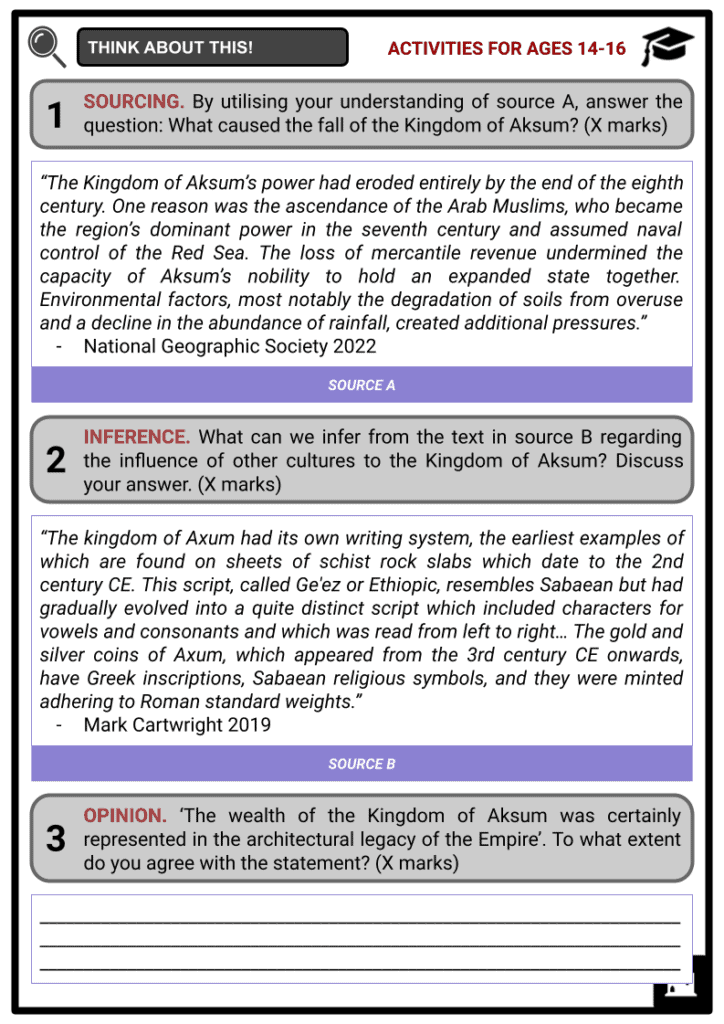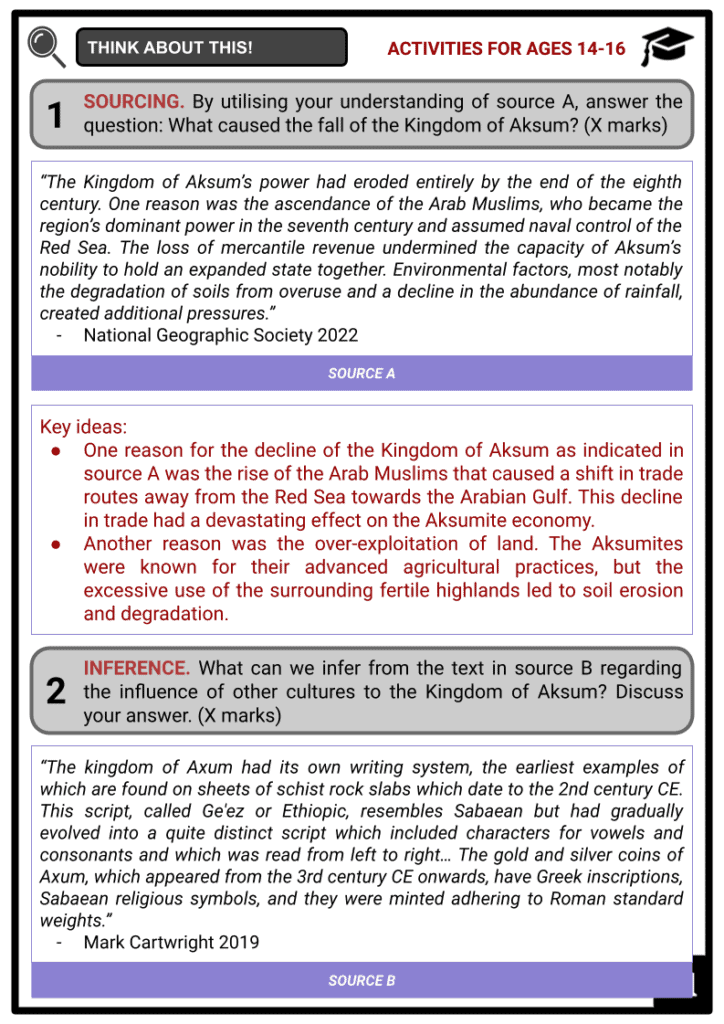Kingdom of Aksum Worksheets
Do you want to save dozens of hours in time? Get your evenings and weekends back? Be able to teach about the Kingdom of Aksum to your students?
Our worksheet bundle includes a fact file and printable worksheets and student activities. Perfect for both the classroom and homeschooling!
Summary
- Establishment and Growth of the Kingdom of Aksum
- Culture of the Kingdom of Aksum
- Art and Architecture
- Religion
- Writing
- Decline of the Kingdom of Aksum
Key Facts And Information
Let’s find out more about the Kingdom of Aksum!
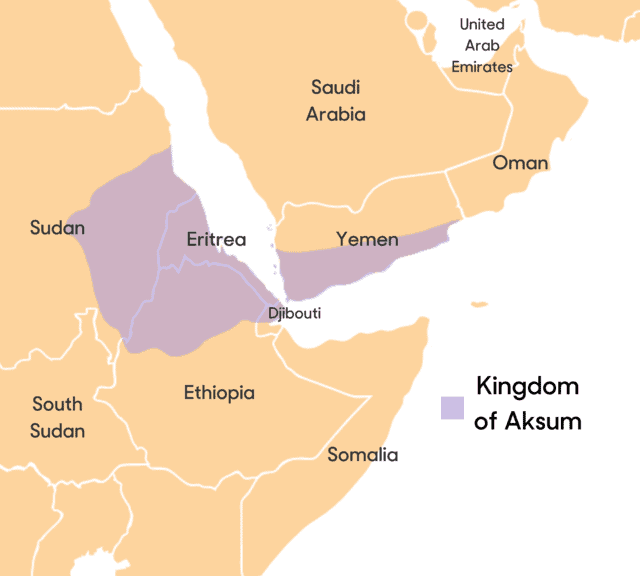
The Kingdom of Aksum, often recognised as one of the most powerful and prosperous empires of the ancient world, emerged in the first century CE in what is now northern Ethiopia and Eritrea. A hub of commerce, Aksum's influence extended across Africa and beyond, to India and even China. Known for its remarkable architectural ingenuity, it is famous for the mysterious obelisks, or 'stelaes', that dot the landscape. The civilisation was also one of the first in the world to adopt Christianity, leaving a lasting religious legacy.
Establishment and Growth
- The Kingdom of Aksum was established in the first century CE, in a region known today as Ethiopia and Eritrea. The roots of its establishment lie in the indigenous agricultural communities that had been settled in the highlands of Ethiopia since 5000 BCE. These communities progressively advanced, developing urban centres with fortified walls. These burgeoning urban societies paved the way for the establishment of the Kingdom of Aksum.
- Aksum's strategic position played a crucial role in its establishment and subsequent expansion. Situated near the Red Sea, it was poised to exploit the commercial opportunities of the time, connecting the major empires of Rome, Persia, and India through an intricate network of maritime trade routes.
- The prosperity of the Kingdom was not determined solely by its geographical location; the leadership of its early rulers was another pivotal factor. King Ezana, for instance, cemented Aksum’s position on the global stage. It was during this time that the characteristic obelisks, or stelae, were constructed.
- In addition, Aksum's control over the Red Sea and the Indian Ocean trade allowed it to amass wealth, leading to the minting of its own currency - a clear indicator of economic stability and progress. Moreover, Aksum's growth can be observed in its cultural and religious transformations. With King Ezana's conversion to Christianity, the Kingdom subsequently adopted the religion, which played a significant role in shaping its identity.
- The construction of stelae, massive stone obelisks often associated with religious practices, also marked the architectural achievements of the period, reflecting the Kingdom's societal and technological advancements. Aksum's establishment and growth are testimony to the dynamism and resilience of an African civilisation that was able to compete, trade, and interact with its contemporaries on an international scale.
Culture
- The culture of the Kingdom of Aksum, deeply embedded in its historical roots, was a profound blend of local traditions and external influences, reflecting its cosmopolitan nature. This amalgamation was evident in various facets of Aksumite society, including its art, architecture, religion, and writing.
Art and Architecture
- The Kingdom of Aksum was rich in artistic heritage, boasting a wide range of artistic styles and forms that were deeply rooted in their beliefs and customs. Aksumite art was characterised by its monumental architecture, intricate stone carvings, and detailed metalwork.
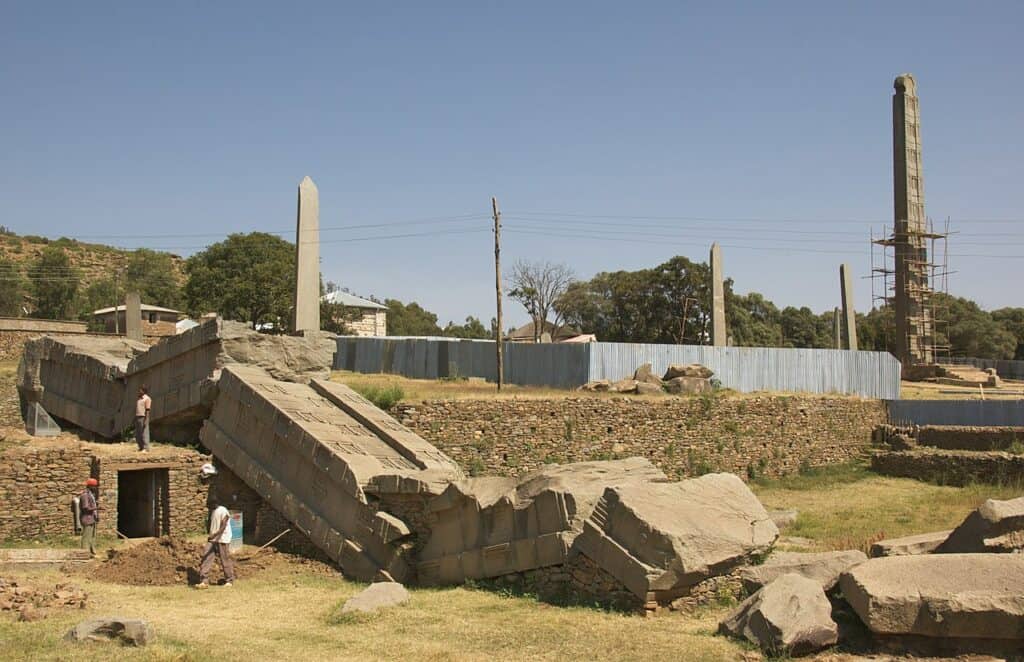
Ruins of the Great Stelae - The most iconic of Aksum's architectural achievements were the stelae, gargantuan obelisks made from single pieces of granite that represented an incredible feat of engineering and artistic design. These monolithic structures, some of which towered over 20 metres high, were often inscribed with intricate details, embodying the Aksumite's aptitude for detailed craftsmanship and their advanced stone-working techniques.
- Each stelae, hewn from a single piece of stone, was meticulously crafted, revealing the Aksumites’ intricate understanding of stone carving and engineering. The tallest standing stelae, known as the Great Stelae, is believed to have been more than 33 metres high, making it one of the largest monoliths in the world.
- These stelae served a dual purpose – religious and funerary. They were primarily erected in honour of deceased kings and nobles, acting as indicators of their burial sites. The detailed inscriptions and carvings on the stelae often depicted the deceased's achievements and wealth, offering us valuable insights into their lives and the socio-political climate of the time.
- The architectural designs of the Kingdom extended beyond the stelae to include palaces, places of worship, and public buildings. The structures, typically constructed with finely cut stones, exhibited a distinct style reflecting the Aksumite's advanced understanding of stonework and construction.
- The ruins of the Ta'akha Maryam and Dungur palaces in Aksum symbolise this architectural prowess, with their complex layouts and sophisticated features such as drainage systems and intricate decorations.
- Religious architecture in the Kingdom also bore witness to the architectural and artistic brilliance of the Aksumites. The church of St. Mary of Zion, believed to house the biblical Ark of the Covenant, is an illustrious example. A blend of local and foreign influences, it embodied the Aksumite's ability to integrate exterior design elements to create a unique architectural style.
- Aside from architecture, Aksumite craftsmen were renowned for their mastery of metalwork. They created a variety of items, from ornate jewellery to religious icons, using precious metals like gold and silver.
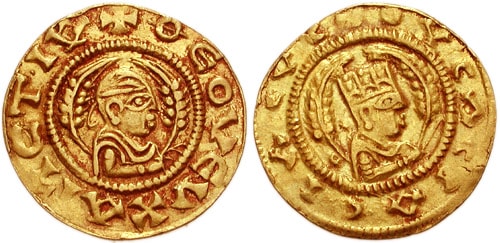
Aksumite gold coin - The coins minted during this period also showcase the Aksumites' metalworking prowess and artistic sensibilities. The coins often bore the images of the reigning king, and after the introduction of Christianity, Christian symbols began to appear, allowing historians to piece together the kingdom's religious transformation.
- In the realm of pottery, Aksumites made a great impact with their distinctive, figuratively decorated ceramics. These ceramics, often adorned with animal and human figurines, provide a unique insight into the day-to-day life of Aksumite society.
Religion
- Religion played a pivotal role in the Kingdom of Aksum, significantly influencing its cultural, political, and social aspects. The Aksumites initially practised a polytheistic religion, with a pantheon of gods, until the introduction of Christianity in the 4th century CE. This religious transformation was spearheaded by King Ezana, who adopted Christianity and declared it the kingdom's official religion.
- The adoption of Christianity had profound impacts on the Kingdom of Aksum. It deeply integrated into the societal fabric, shaping the kingdom's laws, customs, and way of life. This shift is evident in the architectural realm as churches, like the Church of St. Mary of Zion, were built, reflecting the kingdom's religious transformation and embodying a unique blend of local and foreign architectural influences.
- On the political front, the adoption of Christianity strengthened Aksum's relations with the Christian Roman Empire, opening avenues for trade, diplomatic relations, and cultural exchanges. It also unified the kingdom, providing a common religious identity and a shared moral code.
- In the artistic realm, the influence of Christianity is visible in the Aksumite coins. After the introduction of Christianity, Christian symbols began to appear on the coins, replacing the images of the Aksumite gods. This marked a significant shift in the kingdom’s artistic expression, reflecting the changing religious beliefs and societal values.
- The impact of religion on Aksumite society is also evident in the realm of pottery. After the advent of Christianity, Aksumite ceramics began to feature Christian symbols and themes, showcasing the deep religious faith of the Aksumites.
- The impact of Christianity in Aksum extended far beyond the kingdom's borders, influencing the religious landscape of Africa as a whole. As one of the earliest African states to adopt Christianity, Aksum became a beacon of this faith on the continent. Its strategic location on the Red Sea trade routes enabled the spread of Christianity to other parts of Africa, setting the stage for the religion's growth and subsequent influence in regions like Nubia and Ethiopia.
- The adoption of Christianity by Aksum significantly shaped not only its own cultural and societal identity, but also the religious, cultural, and historical narrative of Africa as a whole.
Writing
- The Aksumites developed a script known as Ge'ez, a unique writing system that marked a significant achievement in the history of written language in Africa.
- Ge'ez initially evolved from the South Arabian script, brought over through the trade routes from across the Red Sea. However, the Aksumites adapted this script to suit their language and culture, creating a form of writing that was distinctly their own. The script consisted of an abugida, a type of alphasyllabary where each character represents a consonant-vowel sequence.
- The Ge'ez script flourished with the growth of Christianity, as it became the medium for transcribing religious texts. The Church encouraged literacy, leading to the proliferation of Ge'ez literature and the preservation of historical records. Given its religious significance, Ge'ez was often inscribed on stone stelae, coins, and architecture, serving as a testament to Aksumite culture.
- Over time, Ge'ez evolved into a liturgical language for the Ethiopian Orthodox Tewahedo Church and the Eritrean Orthodox Tewahedo Church. Even though it is no longer used as a native language, it is still used in religious rituals and scholarly contexts, thus continuing to influence Ethiopian and Eritrean societies.

Ethiopian Orthodox Tewahedo Church
Decline
- The decline of the Kingdom of Aksum, once a thriving and influential power, can be traced back to a series of interconnected events and unfavourable circumstances that unfolded over several centuries.
- The primary cause was the over-exploitation of the land. The Aksumites were known for their advanced agricultural practices, but the excessive use of the surrounding fertile highlands led to soil erosion and degradation.
- This, in turn, adversely affected agricultural yield, leading to food shortages and famine, crippling the once- prosperous society.
- Another significant contributory factor was the change in trade routes. The Kingdom of Aksum's wealth was built on its strategic position in the Red Sea trade network, linking the Roman Empire and India.
- However, the rise of the Islamic Caliphate in the 7th century caused a shift in trade routes away from the Red Sea towards the Arabian Gulf. This decline in trade had a devastating effect on the Aksumite economy.
- Furthermore, the Kingdom suffered from internal conflicts and power struggles, which weakened it from within. The centralised authority that had once held the Kingdom together started to crumble, paving the way for regional powers to emerge.
- Religious conflicts also played a role in the decline. The Kingdom of Aksum was staunchly Christian in an increasingly Muslim region. This isolation, both religious and trade-related, led to Aksum's gradual recession from the political and economic stage of the world.
- The Kingdom of Aksum didn't fall overnight but gradually faded into obscurity over the centuries. By the end of the 10th century, it was replaced by the Zagwe Dynasty, marking the end of the Aksumite era.
- Despite its decline, the legacy of the Kingdom of Aksum lives on in the form of its distinctive architectural and artistic accomplishments, as well as its significant influence on Christianity in Africa.
Image Sources
- https://upload.wikimedia.org/wikipedia/commons/thumb/6/63/Kingdom_of_Aksum_Map.png/640px-Kingdom_of_Aksum_Map.png
- https://upload.wikimedia.org/wikipedia/commons/thumb/7/76/The_North_Stelae_Park%2C_Axum%2C_Ethiopia_%282812686646%29.jpg/1280px-The_North_Stelae_Park%2C_Axum%2C_Ethiopia_%282812686646%29.jpg
- https://upload.wikimedia.org/wikipedia/commons/a/ae/Ousas.jpg
- https://upload.wikimedia.org/wikipedia/commons/thumb/9/9e/Addis_abeba%2C_chiesa_della_trinit%C3%A0%2C_esterno_01.jpg/1920px-Addis_abeba%2C_chiesa_della_trinit%C3%A0%2C_esterno_01.jpg
Frequently Asked Questions
- What was the Kingdom of Aksum?
The Kingdom of Aksum, or the Aksumite Empire, was an ancient civilisation in present-day Ethiopia and Eritrea. It was a powerful trading empire and a significant player in the Red Sea trade routes from the 1st century CE to the 7th century CE.
- What were the significant achievements of the Kingdom of Aksum?
The Kingdom of Aksum was known for its advanced architecture, including the famous stelae (obelisks), intricate coinage, and sophisticated irrigation systems. It was also one of the earliest adopters of Christianity, making it one of the first Christian nations in the world.
- What is the Kingdom of Aksum called today?
The Kingdom of Aksum, an ancient civilisation in present-day Ethiopia and Eritrea, is still referred to as Aksum in modern times. The contemporary town of Aksum, located in the Tigray Region of Ethiopia, is near the archaeological sites of the ancient Aksumite Empire.

